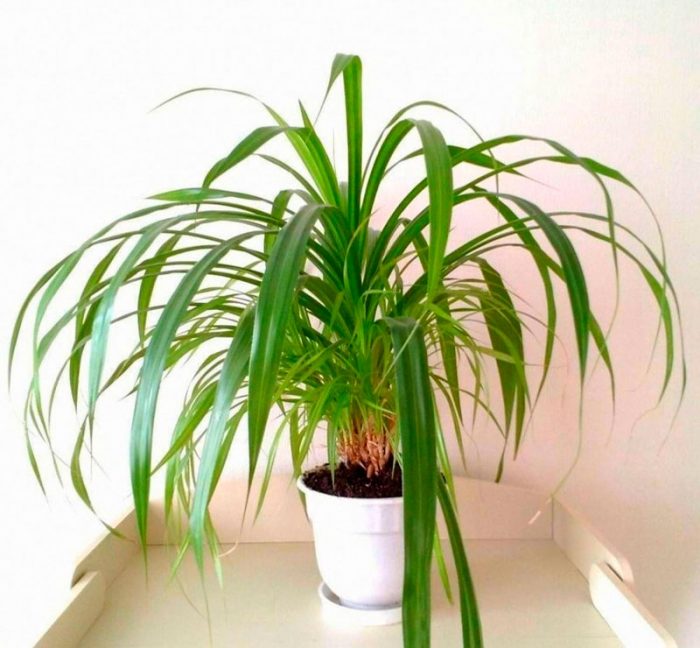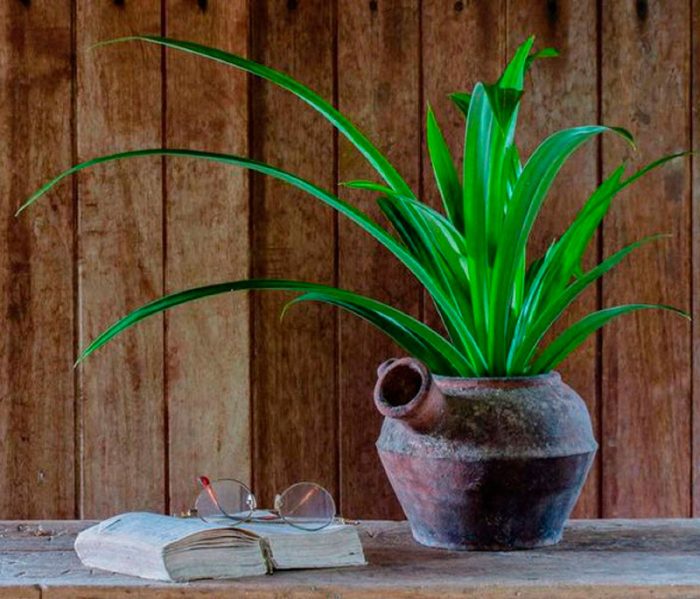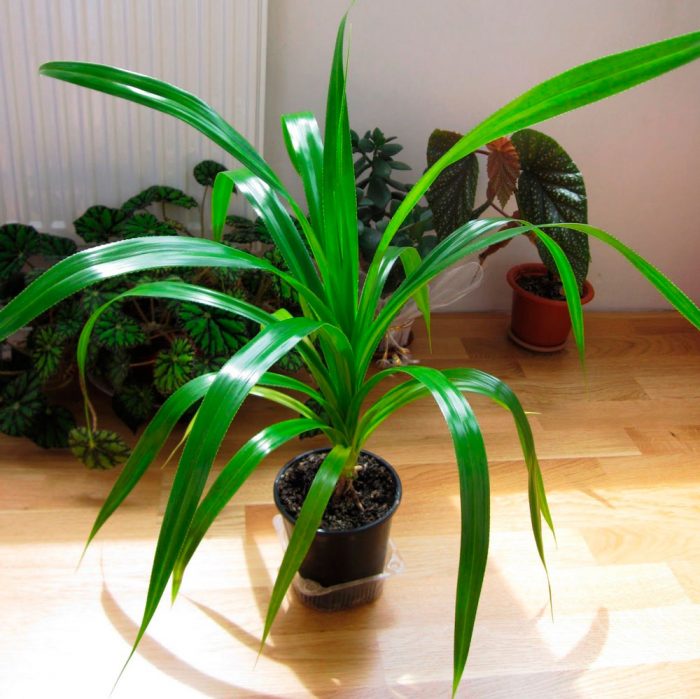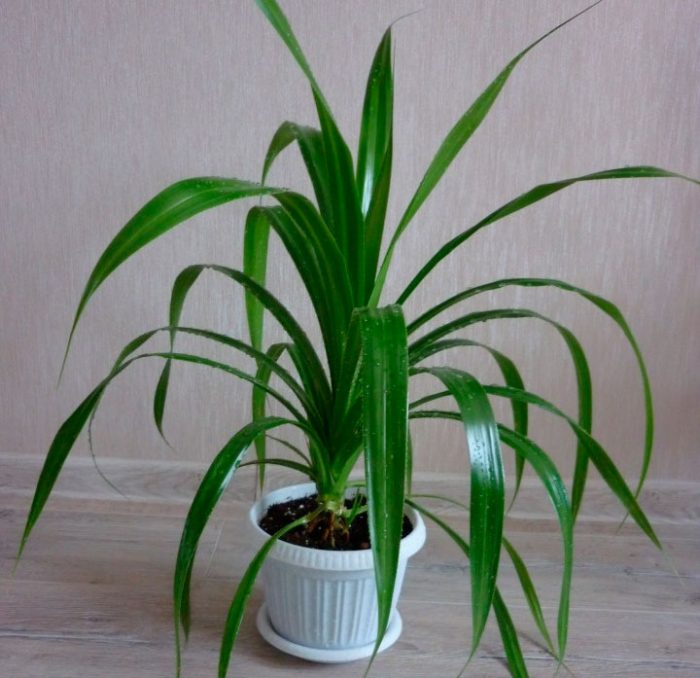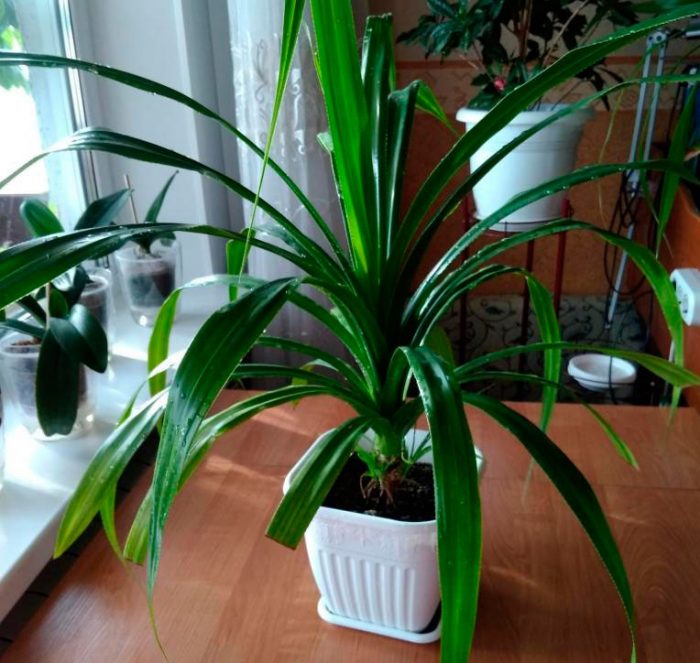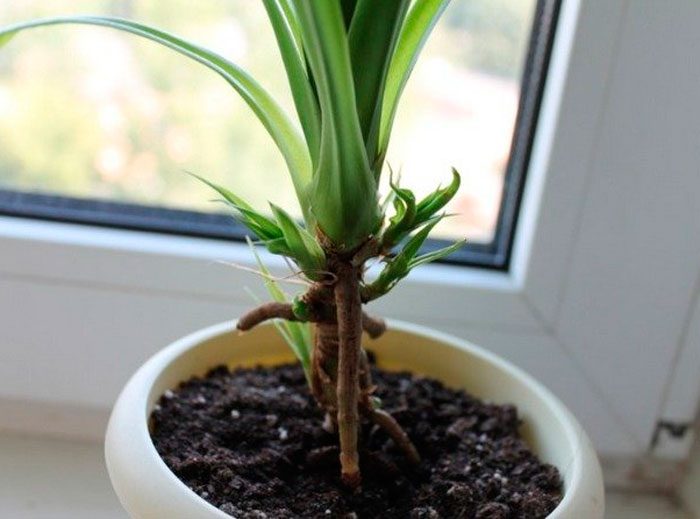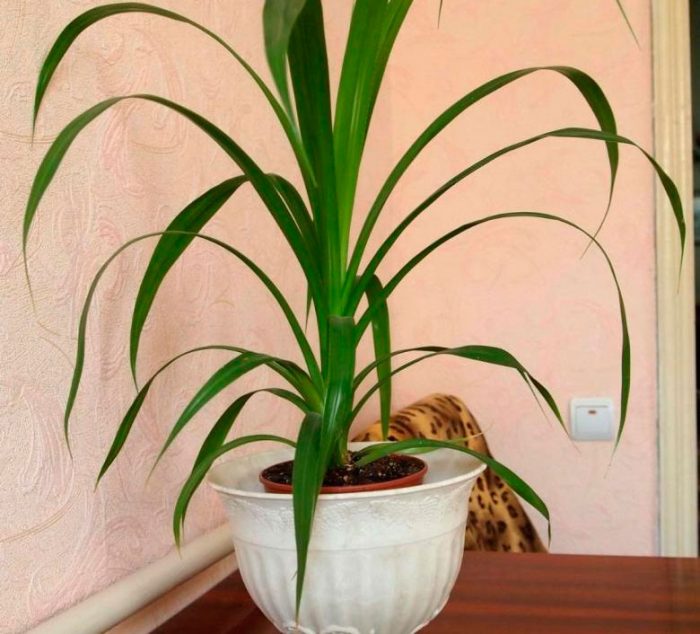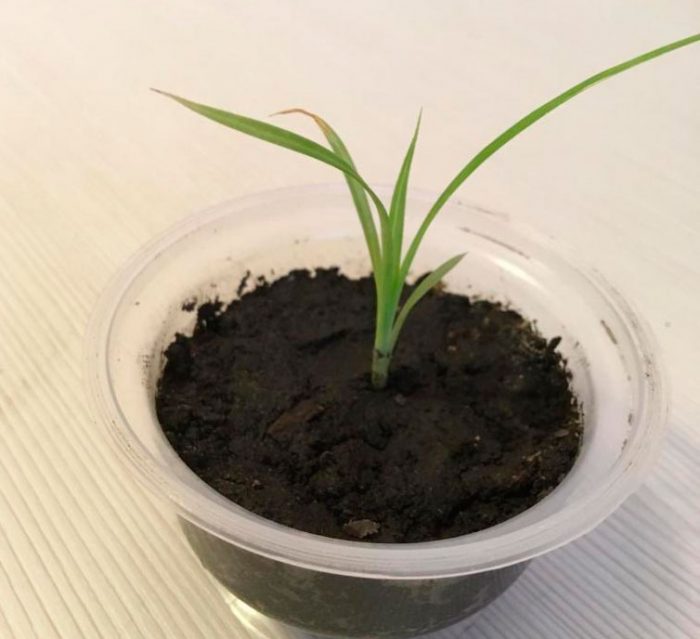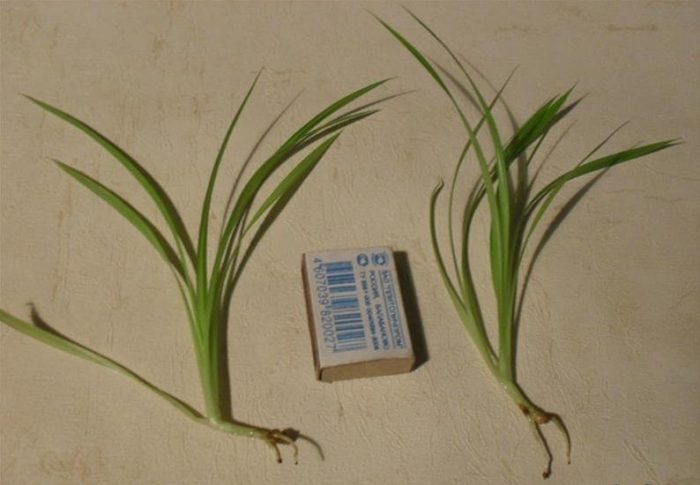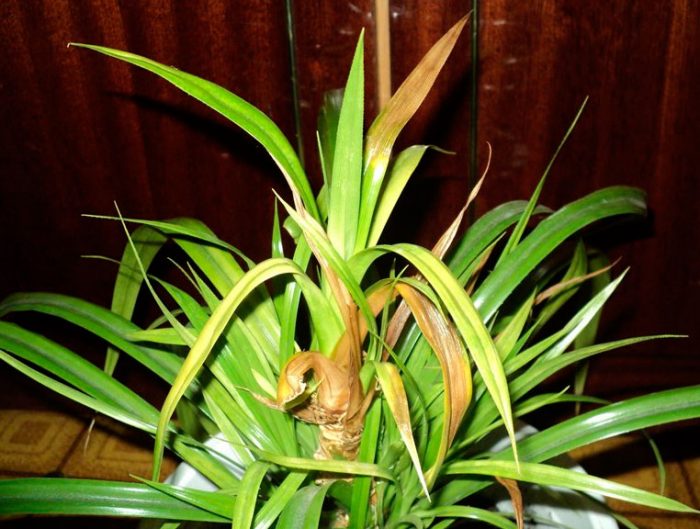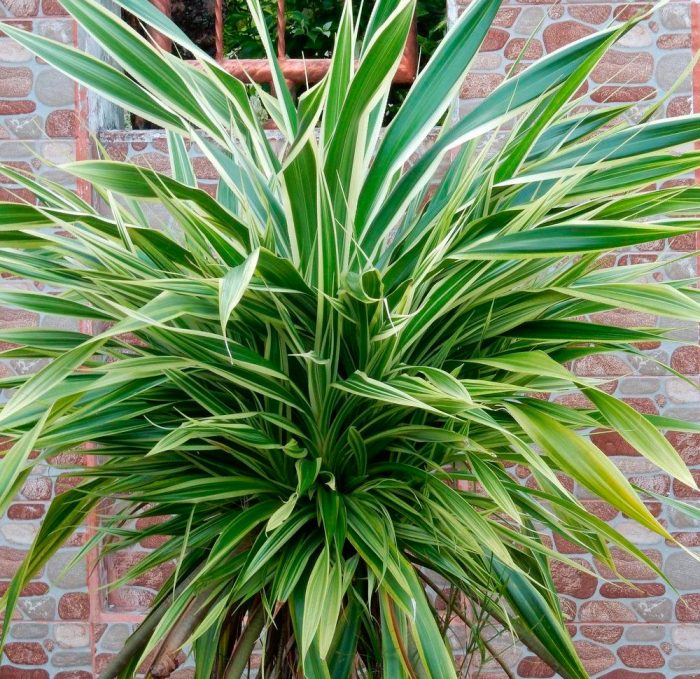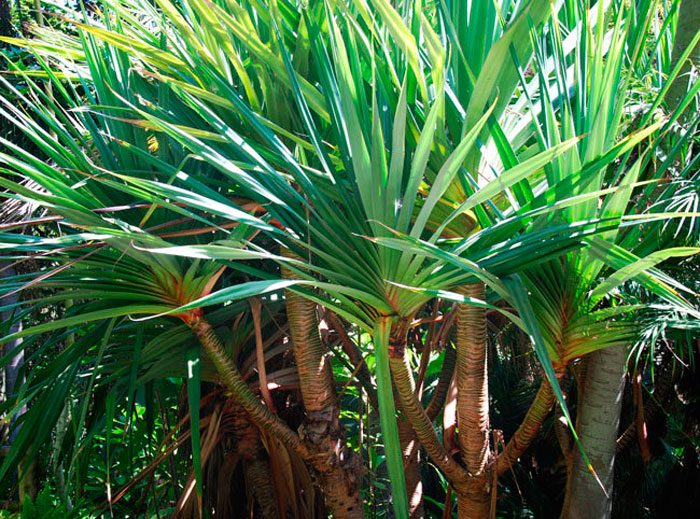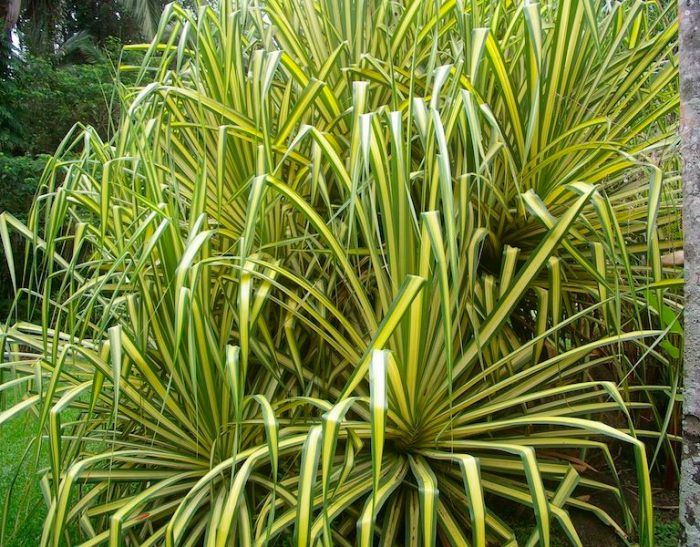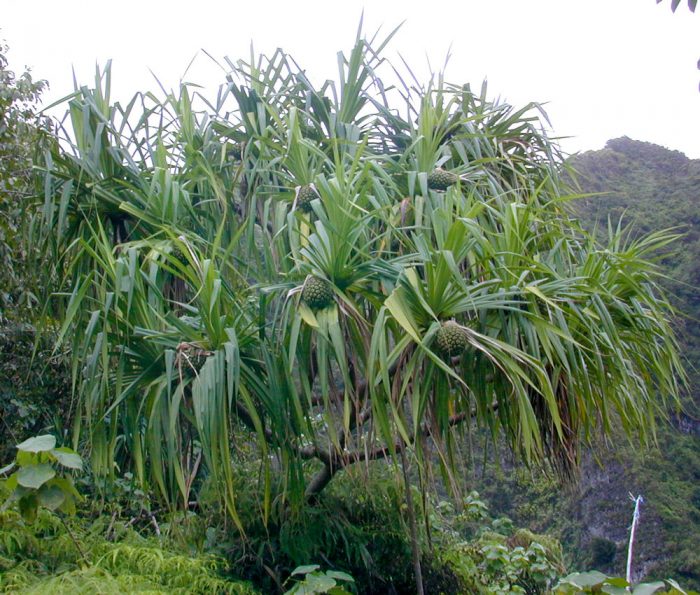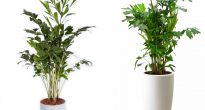The pandanus tree plant, also called the pandanus, is part of the Pandanus family. This genus includes about 750 species that are most often found in the Eastern Hemisphere in areas with a tropical climate. In nature, pandanas can be found in Hawaii, in the eastern part of North India, in West Africa, along the coast of Western India, in the lowlands of Nepal, in Vietnam, as well as from Polynesia to Australia. And on the island of Madagascar, there are about 90 different species of pandanus. Such a plant can adapt to a wide variety of conditions: it can grow on river banks, in alpine and mountain forests, on coral reefs, on the seashore, in swamps and on the slopes of a volcano.
Content
Brief description of cultivation
- Bloom... Pandanus is cultivated as an ornamental deciduous plant.
- Illumination... In the spring-summer period there is a slight shading, and in the autumn and winter time there is a bright light, which must be necessarily diffused. In the warm season, the plant is recommended to be grown on a window of either western or eastern orientation.
- Temperature regime... Throughout the year - from 19 to 25 degrees. Make sure that the temperature in the room does not drop below 12 degrees.
- Watering... In the warm season, it is necessary to water it systematically and abundantly; this procedure is carried out immediately after the top layer of the soil mixture in the container dries out. In the autumn-winter period, watering should be more rare and moderate.
- Air humidity... Common for living rooms. It is highly undesirable to moisten foliage from a sprayer or wash it. If the room has excessively low air humidity, then the container with the plant is placed on a pallet filled with wet expanded clay.
- Fertilizer... The plant is fed regularly once every 2 weeks from March to August, for this they use a complex mineral fertilizer for decorative deciduous plants. In the autumn-winter period, the pandan does not need fertilization.
- Dormant period... Not pronounced.
- Transfer... While the bushes are young, they are transplanted regularly once a year, and starting from the age of three, this procedure is carried out only if necessary, when the root system ceases to fit into the pot (as a rule, this happens on average once every 2 or 3 years). The transplant is carried out by the transshipment method.
- Reproduction... By dividing the bush, by cuttings, less often by seed.
- Harmful insects... Scabbards, false scutes, mealybugs and spider mites.
- Diseases... Root rot.
Features of the pandanus
Pandanus is an evergreen tree plant, but shrubs are also occasionally found. Under natural conditions, the height of such a plant can reach 10-15 meters, and sometimes it can be up to 25 meters. The appearance of a pandanus is similar to a palm tree or a liana. Often, it forms aerial roots, which after a while grow into the ground. Over the years, the pandanus dies off the lower part of the trunk, but it does not fall, but is kept in an upright position due to lignified aerial roots that have grown into the ground, they are also called stilted. The xiphoid linear slightly grooved leaf plates reach up to 15 centimeters in width and about 4 meters in length, their edge is sharply serrated. The foliage on the trunk is located in 2 spiral rows, in this regard, this plant is sometimes called a "spiral palm" or "spiral tree". As the pandanus grows, its lower leaf plates fly around, and scars remain at the place where they were attached. During flowering, cobs or panicle inflorescences appear, which consist of unisexual small yellow flowers without a perianth. However, blooming indoor pandanus is extremely rare. This plant is distinguished by its unpretentiousness, and it is perfect for winter gardens and large halls. Poor lighting and a lack of moisture are very persistently tolerated by the fast-growing pandanus, however, only young specimens can be grown in room conditions, since adult plants require quite a lot of space.
Caring for pandanus at home
Illumination
Pandanus needs a lot of bright light in the autumn-winter period, and in the warm season it needs a little shading. It will grow beautifully on west or east windows. If the lighting is too scarce, then after a short time the leaf plates of the plant will lose their turgor, because of which they will begin to bend. Plus, due to the lack of light, forms with variegated foliage lose their unusual color.
If there is too little light for the plant, then not far from the bush (at a distance of 0.6 to 0.7 m) additional lighting should be installed, and during the day it should work for at least 8 hours. If the bush will always stand in one place relative to the light source, then it will become "one-sided", which is why the pot with it is regularly rotated a little around its axis.
Temperature regime
In the cold season, the room where the plant is located must be systematically ventilated, but do not allow the pandanus to be exposed to a draft. The plant grows well and develops all year round at an air temperature of 19 to 25 degrees, and it does not need to lower the temperature in winter. However, make sure that the room is not colder than 12 degrees, as this may cause the pandanus to die.
Air humidity
Such a plant does not need high humidity. However, if the room has a very low level of air humidity, then to increase it, it is recommended to pour wet expanded clay or pebbles into the pallet, and then put a flower pot on it. It is impossible to wash the foliage or moisten it from its sprayer, since when droplets of water get into the leaf sinuses, rot appears on the stem.However, if desired, the sheet plates can be wiped from dust with a damp sponge or soft cloth, and you need to move from the base to the top. They must wipe the foliage with gloves, since there are thorns on its surface.
Aerial roots
When grown at home, pandanus very rarely form aerial roots. If they nevertheless formed on your bush, then in no case break them off. Instead, it is recommended to overlay such roots with moistened sphagnum in order to prevent them from drying out, while making sure that the moss is always slightly damp. Particular attention should be paid to this in the summer. If the bush does not form aerial roots at all, then after some time it will become less stable.
Watering
In the warm season, the pandanus is watered regularly and abundantly, and the procedure is carried out two or three days after the top layer of the soil mixture in the container dries out. In no case do not allow the clod of earth in the pot to dry out. For irrigation, be sure to use warm (about 35 degrees) and well-settled water. When 30 minutes have passed from the moment the substrate is moistened, the excess liquid, which is glass in the pan, is drained. In the autumn-winter period, the amount and abundance of watering is reduced.
Fertilizer
Throughout the spring and summer (from March to August), the bush is regularly fed twice a month, for this they use a complex mineral fertilizer for decorative leafy plants. In the autumn-winter period, fertilizer does not need to be applied to the substrate.
Pandanus transplant
The transplant of such a plant is carried out only if necessary, or rather, when the root system becomes very cramped in the container. As a rule, young bushes are transplanted once a year, and adults - once every 2 or 3 years.
Be very careful when transplanting as the roots of the pandanus are very fragile. That is why it is recommended to carefully transfer the bush from the old pot to the new one. A soil mixture suitable for transplantation should consist of humus, sand, sod and leafy soil (taken in equal parts). The container for planting is taken high, and a thick drainage layer is made at its bottom, which should occupy 1/3 of the entire volume of the pot.
Before transplanting, gently lift the foliage up above the bush and tie it. After that, it is very carefully transferred from the old container to a new one, and then all the voids are filled with fresh earth mixture. During transplanting, make sure that the plant in the new pot is at the same level as in the old one.
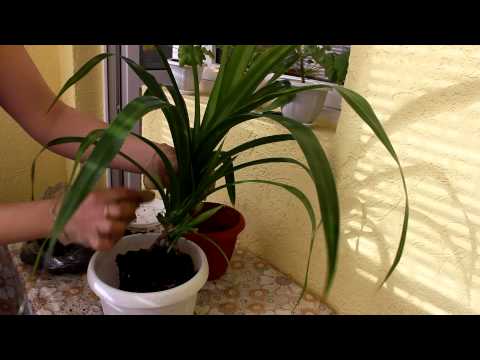

Watch this video on YouTube
Reproduction methods
Indoor pandanus can be propagated in several ways, namely by dividing the bush, by seeds and cuttings.
Growing from seeds
For sowing, freshly harvested seeds are used in compound fruits. To do this, you need a small container, which is filled with a mixture of leafy soil and sand (1: 1) or peat and sand (1: 1). Crops from above must be covered with glass or foil. They are transferred to a warm place (no colder than 25 degrees), while they are provided with systematic ventilation and humidification of the substrate from a spray bottle. Seedlings appear in groups 15-30 days after sowing. However, if the crops are removed in a mini-greenhouse with bottom heating, then the first shoots will appear much earlier.
After the plants have formed 2 or 3 true leaf plates, they are dived into individual pots, which are filled with a soil mixture consisting of sand, sod and leafy soil (1: 1: 1).
Cuttings
For harvesting cuttings, side shoots are used. In length, the cuttings should reach at least 20 centimeters, because if they are shorter, then they will grow very poorly new roots. All cut sites are treated with carbon powder, and then they are allowed to dry.For rooting, cuttings are planted in a soil mixture consisting of sand and peat (1: 1), and on top they must be covered with a transparent bag or a glass cap. For successful rooting, the cuttings must be warm (from 25 to 28 degrees), while they are provided with systematic ventilation and watering, which is carried out using a spray bottle. Typically, cuttings are fully rooted after 6–8 weeks. However, when using an agent that stimulates root growth and a mini-greenhouse, the roots of cuttings grow faster.


Watch this video on YouTube
Dividing the bush
In an adult plant, many daughter rosettes are formed at the base of the trunk, as well as in the leaf sinuses. When the rosettes are 20 centimeters long and have grown roots, they can be separated from the parent bush. To speed up the process of regrowth of roots in children, their bases are covered with wet moss, while making sure that the sphagnum does not dry out. After the baby is trimmed, it is left for 24 hours to dry.
For planting the sockets, a flat container is used, at the bottom of which a drainage layer 15–20 mm thick is made. Then a layer of soddy soil 60–70 mm thick is poured into the container, and sprinkled with a layer of washed sand (thickness from 30 to 40 mm). The roots of the child are buried in the sand by 20 mm, which is then well compacted around the bush. The surface of the sand is carefully moistened with a spray bottle, and then the baby is covered on top with a transparent bag or glass cap. Please note that the temperature of the substrate in the container must be at least 22 degrees, otherwise the baby may not take root. It should be fully rooted after 4–6 weeks. To make the roots of the industry faster, you can use phytohormones.
After a couple of months, the rooted baby, taken together with a lump of earth, is planted in a larger pot, and it is filled with a soil mixture consisting of leafy and turfy soil, as well as sand (3: 2: 1).
Diseases and pests of pandanus
Pests
Grown indoors, pandanus is quite resistant to pests, but nevertheless, worms, scale insects or spider mites sometimes settle on it. Due to the scale insects, brown scaly formations appear on the surface of the foliage, and they also leave a rather sticky discharge. In order to destroy such pests, the bush is sprayed with a solution of Karbofos or Actellik. If mealybugs have settled on the plant, then first they are removed with a brush or cotton swab moistened with alcohol, and only after that it is treated with an anti-acaricidal agent, for example, Diklox, Tolkoks or Koktsigard.
If there is excessively dry air in the room, this can cause spider mites to appear on the pandanus. Their presence can be recognized by punctures (dots) on the sheet plate, which eventually merge with each other. In this case, spraying with an acaricidal preparation is carried out (for example, Aktara or Aktellik). Then the humidity level of the air must be increased, for this, wet expanded clay is poured into the pallet, and a pot with a bush is placed on it.
Yellow foliage
Pandanus is highly resistant to various diseases, but its leaf plates may begin to turn yellow. This can be due to the use of hard water for irrigation, too much light, or because there is too much calcium in the substrate.
If the plant does not have enough light, then the foliage shrinks, and in variegated forms their bright color disappears. Due to too dry air, the tips of the leaves turn brown and dry out. To prevent this, the flower pot is constantly kept on a pallet filled with wet expanded clay or pebbles.
Pandanus species
Pandanus Veitch, or Veitch (Pandanus veitchii)
This tree-like plant is evergreen and is found naturally in Southeast Asia.Its trunk is shortened, and aerial support-roots depart from it. The length of green spirally arranged leaf plates is about 100 cm, and their width is from 5 to 8 cm, they are decorated with white edging, and there are also many light-colored thorns with white tips on the edge. For 10 years at home with good care, the bush can grow up to 150 cm in height.In culture, it practically does not bloom.
Pandanus utilis
This large plant in natural conditions reaches a height of about 20 meters, while in culture its height, as a rule, does not exceed 200-300 cm. This species does not bloom at home. And since this plant branches only after flowering, it does not branch in culture. The foliage is arranged helically along the trunk, it is dark green and tough. Its length varies from 100 to 150 cm, and its width is from 5 to 10 cm, on the edge there are many spines of a pale red color.
Pandanus sanderi
In nature, the species is found in the tropical humid forests of the Malay Archipelago. Its short trunk is decorated with dark green leaf plates, on the surface of which there are longitudinally narrow yellow stripes. The foliage is about 80 centimeters long and about 5 centimeters wide; there are thorns on its edge, but there are not many of them.
Covering Pandanus (Pandanus tectorius)
This species is represented by a branched evergreen shrub, which has stilted roots, in nature it reaches a height of 300 to 400 cm.The linear leaf plates are strongly narrowed towards the top, and on their edge there are narrow white thorns. Under natural conditions, this species grows red, yellow or orange fruits, which are very tasty and sweet. At home, such a plant blooms extremely rarely and does not form fruit. Quite often, you can meet the laevis variety: the foliage reaches about 200 cm in length and does not have thorns, flowers with a diameter of 50-100 mm are painted in pale pink or white.
Signs associated with pandanus
Some flower growers hesitate to decorate their home with pandanus, because they do not know for sure whether it can be kept in their home? The fact is that there is an opinion among the people that this plant is capable of absorbing all positive emotions, after which it transforms them into aggressive energy, which has an extremely negative effect on unbalanced people, as a result of which they become overly active and angry. Experts do not advise getting this flower to impressionable people who are extremely difficult to endure any troubles, since they may feel uncomfortable next to a pandana.
This plant is suitable for people with a strong nervous system, as well as for beginners and experienced flower growers. It can also be grown by those who often go on business trips, since it is distinguished by its unpretentiousness, rapid growth, and it does not need to be watered often.
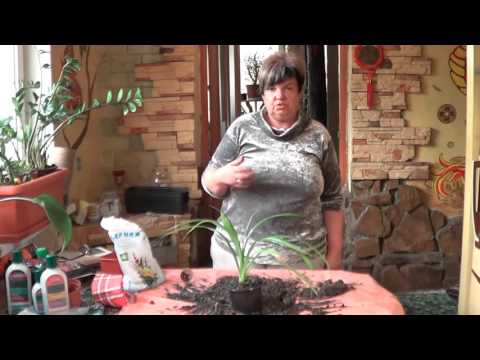

Watch this video on YouTube

